Filters: School Or College: "College of Science" Department: "Chemistry" Collection: "ir_uspace" Format: "application/pdf"
| Creator | Title | Description | Subject | Date | ||
|---|---|---|---|---|---|---|
| 1 |
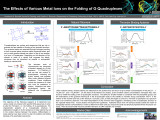 |
Borodai, Anastasia S. | The effects of various metal ions on the folding of G-quadruplexes | Divalent metal cations inhibit the folding of G-Quadruplexes | G-Quadruplex; Divalent cations; Metal ions; Nucleic acids; Guanine; Tetrads | 2015-03-31 |
| 2 |
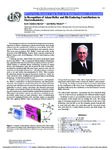 |
Minteer, Shelley D. | In recognition of Adam Heller and his enduring contributions to electrochemistry | Recent progress in diverse scientific fields ranging from bioelectrochemistry to battery technology to photoconversion has been deeply influenced by the contributions of Professor Adam Heller of the University of Texas at Austin to electrochemistry and materials science. This focus issue recognizes ... | 2014-01-01 | |
| 3 |
 |
Fleming Aaron M. | Computational studies of electronic circular dichroism spectra predict absolute configuration assignments for the guanine oxidation product 5-carboxamido-5-formamido-2-iminohydantoin | Oxidation of the guanine heterocycle by two electrons can yield the chiral product 5-carboxamido-5-formamido-2-iminohydantoin (2Ih). The 2Ih free base enantiomers were synthesized from 2'-deoxyguanosine oxidized with a Cu(II)/H2O2 oxidant system followed by hydrolysis of the N-glycosidic bond. These... | Guanine oxidation; 2-Iminohydantoin; Electronic circular dichroism; Time-dependent density functional theory | 2014-12-15 |
| 4 |
 |
Minteer, Shelley D. | Photobioelectrochemistry: Solar energy conversion and biofuel production with photosynthetic catalysts | Photobioelectrochemical cells are devices which have been developed over the past few decades and use photosynthetic catalysts for solar energy conversion or biofuel production. In this paper, a critical review of reported photobioelectrochemical systems is presented. The systems discussed include s... | 2014-01-01 | |
| 5 |
 |
Minteer, Shelley D. | Investigating the reversible inhibition model of laccase by hydrogen peroxide for bioelectrocatalytic applications | The reversible inhibition of laccase by H2O2 as a bioelectrocatalyst was studied in mediated- and direct electron transfer-based configurations to understand the differences in mechanism. The reversible inhibition of laccase follows a noncompetitive inhibition model when 2,2-azino-bis(3-ethylbenzoth... | 2014-01-01 | |
| 6 |
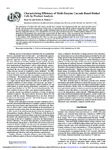 |
Minteer, Shelley D. | Characterizing efficiency of multi-Enzyme cascade-based biofuel cells by product analysis | The performance of biofuel cells with enzyme cascades have normally been characterized with open circuit potential, power density, and current density measurements. In this work, we demonstrate that with the method of quantitative product analysis by mass spectrometry, we can obtain other valuable i... | 2014-01-01 | |
| 7 |
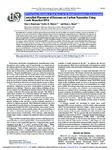 |
Minteer, Shelley D. | Controlled placement of enzymes on carbon nanotubes using comb-branched DNA | Immobilization is not only useful for preserving enzyme activity, but also to adhere an enzyme to a surface, such as an electrode, so that the enzyme does not leach into solution during testing. Current immobilization approaches do not readily allow for adjustments to the distance between the enzyme... | 2014-01-01 | |
| 8 |
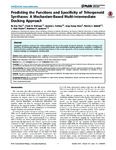 |
Poulter, Charles Dale | Predicting the functions and specificity of triterpenoid synthases: a mechanism-based multi-intermediate docking approach | Terpenoid synthases construct the carbon skeletons of tens of thousands of natural products. To predict functions and specificity of triterpenoid synthases, a mechanism-based, multi-intermediate docking approach is proposed. In addition to enzyme function prediction, other potential applications of ... | 2014-01-01 | |
| 9 |
 |
Poulter, Charles Dale | Tetartohedral twinning in IDI-2 from Thermus thermophilus: crystallization under anaerobic conditions | Type-2 isopentenyl diphosphate isomerase (IDI-2) is a key flavoprotein involved in the biosynthesis of isoprenoids. Since fully reduced flavin mononucleotide (FMNH2) is needed for activity, it was decided to crystallize the enzyme under anaerobic conditions in order to understand how this reduced co... | 2014-01-01 | |
| 10 |
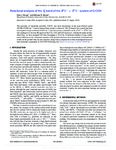 |
Morse, Michael David | Rotational analysis of the 30 1 band of the Ã6Σ+ ← X̃6Σ + system of CrCCH | The spectrum of chromium acetylide, CrCCH, has been investigated in the near-infrared region (10 500-14 500 cm−1) and an intense band system is observed. The 310 band of this system has been investigated at high resolution (0.025 cm−1) and this system is identified as the ˜A6 + ← ˜X6 + syste... | 2014-01-01 | |
| 11 |
 |
Armentrout, Peter B. | Theoretical investigation and reinterpretation of the decomposition of lithiated proline and N-Methyl Proline | Lithium cation complexes of proline (Pro) and N-methyl proline (NMP) have been collisionally activated with xenon in a guided ion beam tandem mass spectrometer (GIBMS). In addition to the loss of the intact ligand, Pro and NMP, we observed two prominent fragmentation pathways involving the loss of (... | 2014-01-01 | |
| 12 |
 |
Minteer, Shelley D. | Nickel cysteine complexes as anodic electrocatalysts for fuel cells | Compared to platinum, nickel is an inexpensive catalyst that can oxidize methanol in alkaline media. There is a desire to increase nickel loading during electrodeposition for improved performance. In this paper, a nickel cysteine complex (NiCys) is used as the precursor for electrodeposition on glas... | 2014-01-01 | |
| 13 |
 |
Armentrout, Peter B. | The bond energy of ReO+: Guided ion-beam and theoretical studies of the reaction of Re+ (7S) with O2 | The kinetic-energy dependence of the Re+ + O2 reaction is examined using guided ion-beam mass spectrometry. The cross section for ReO+ formation from ground state Re+ (7S) is unusual, exhibiting two endothermic features. The kinetic energy dependence for ReO+ formation is analyzed to determine D0(Re... | 2013-01-01 | |
| 14 |
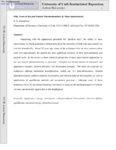 |
Armentrout, Peter B. | Fifty years of ion and neutral thermochemistry by mass spectrometry | Originating with the appearance potentials for "positive rays", the ability of mass spectrometry to obtain quantitative information about the energetics of both ions and neutrals has evolved dramatically. About 50 years ago, many of the techniques that are now common place were first implemented, th... | 2014-01-01 | |
| 15 |
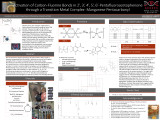 |
Borodai, Anastasia S. | C-F bond activation | Activation of Carbon-Fluorine Bonds in 2', 3', 4', 5', 6'-Pentafluoroacetophenone through a Transition Metal Complex- Manganese Pentacarbonyl | Carbon; Fluorine; Bond; Activation | 2014-05-30 |
| 16 |
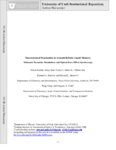 |
Voth, Gregory Alan | Nanostructural organization in acetonitrile/ionic liquid mixtures: molecular dynamics simulations and optical Kerr effect spectroscopy | In this paper, the nanostructural organization and subpicosecond intermolecular dynamics in mixtures of acetonitrile and the ionic liquid (IL) 1-pentyl-3-methylimidazolium bis{(trifluoromethane)sulfonyl}amide ([C5mim][NTf2]) were studied as a function of concentration using molecular dynamics (MD) s... | 2012-01-01 | |
| 17 |
 |
Armentrout, Peter B. | Thermodynamics and mechanism of protonated cysteine decomposition: a guided ion beam and computational study | A quantitative molecular description of the decomposition of protonated cysteine, H+Cys, is provided by studying the kinetic energy dependence of threshold collision-induced dissociation (CID) with Xe using a guided ion beam tandem mass spectrometer (GIBMS). Primary dissociation channels are deamida... | 2014-01-01 | |
| 18 |
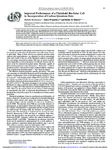 |
Minteer, Shelley D. | Improved performance of a thylakoid bio-solar cell by incorporation of carbon quantum dots | Carbon quantum dots (CQDs) were incorporated into thylakoid bioanodes capable of direct photobioelectrocatalysis in order to increase the photocurrent generation. More thylakoids are in contact with the increased surface area which allows for greater direct electron transfer (DET). Additionally, the... | 2014-01-01 | |
| 19 |
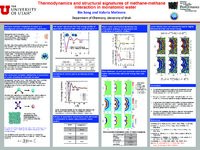 |
Song, Bin; Molinero, Valeria | Thermodynamics and structural signatures of methane-methane in monatomic water | 2013 | ||
| 20 |
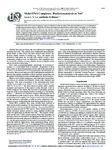 |
Minteer, Shelley D. | Nickel-DNA complexes: bioelectrocatalysis or not? | Alkaline fuel cells (AFC) are low temperature, quick-to-start devices that can achieve 50% operating efficiency. Low cost alternatives to platinum group electrocatalysts, which allow for direct reformation are desired. Nickel electrocatalysts are highly active in alkaline for the oxidation of fuels.... | 2013-01-01 | |
| 21 |
 |
Minteer, Shelley D. | Utilizing DNA for electrocatalysis: DNA-Nickel aggregates as anodic electrocatalysts for methanol, ethanol, glycerol, and glucose | DNA-nickel aggregates were electrodeposited onto glassy carbon electrode surfaces and have shown electrocatalytic activity for oxidation of methanol, ethanol, glycerol, and glucose at room temperature in alkaline solutions. Bulk electrolysis oxidation products identified by 13C NMR include carbonate... | 2013-01-01 | |
| 22 |
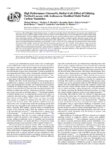 |
Minteer, Shelley D. | High performance glucose/O2 biofuel cell: effect of utilizing purified laccase with anthracene-modified multi-walled carbon nanotubes | Laccase, a blue multicopper oxidoreductase enzyme, is a robust enzyme that catalyzes the reduction of oxygen to water and has been shown previously to perform improved direct electron transfer in a biocathode when mixed with anthracene-modified multi-walled carbon nanotubes. Previous cathode constru... | 2012-01-01 | |
| 23 |
 |
Minteer, Shelley D. | Bio-solar cells incorporating catalase for stabilization of thylakoid bioelectrodes during direct photoelectrocatalysis | Thylakoid membranes have been proposed for electrochemical solar energy conversion, but they have been plagued with short term instability. In this paper, thylakoid membranes extracted from Spinacia oleracea were physically adsorbed onto Toray paper electrodes with and without catalase, followed by ... | 2012-01-01 | |
| 24 |
 |
Yang, Seung Ook | Construction of a protein-based nanoreactor using charge complementarity | 2012 | ||
| 25 |
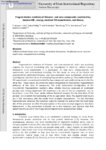 |
Armentrout, Peter B. | Fragmentation reactions of thiourea- and urea-compounds examined by tandem MS-, energy-resolved CID experiments, and theory | Fragmentation reactions of thiourea- and urea-compounds, which are promising reagents for chemical crosslinking (XL), are investigated in detail by collision-induced dissociation (CID) experiments in a quadrupole ion trap (QIT), energy-resolved CID experiments, and computational modeling. For this s... | 2012-01-01 |
